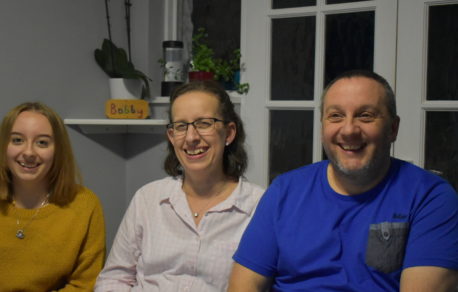
Neurodiversity at work: How leaders and managers can support neurodiverse staff to thrive
Neurodivergent engineer Martin knows what it’s like to feel unsupported in the workplace. In this blog, he shares his advice for managers and team leaders to help them understand how they can empower neurodiverse colleagues to thrive at work, at every stage of the employee lifecycle.
In this blog, you’ll learn:
- The coping mechanisms used by neurodiverse people
- What ‘spiky’ profiles are, and why they matter
- How to support neurodiverse colleagues throughout the employee lifecycle
- How businesses can benefit from embracing neurodiversity
To learn more about Martin’s journey as a neurodivergent engineer, read his first Foothold blog.
My experience as a neurodiverse engineer
As a chartered geologist and engineer, I work for clients across the globe on projects from concept to decommissioning. My work makes me happy and constitutes meaningful full-time employment for me.
That said, I am not a professional in the field of neurodiversity, or a Human Resources Manager. But I am a workplace Justice Equity Diversity Inclusion (JEDI) Champion.
This is a volunteer role that has risen out of necessity to champion neurodiversity at work, and create a fairer and truly diverse world. I am a JEDI Champion with a specific emphasis on dyslexia, dyspraxia, autism and visual impairment – all of which are part of me!
I live my neurodivergent conditions 24/7: they are real, complex, lifelong, messy and unique to me. All my conditions are invisible – either disabilities or superpowers, limitations or strengths, depending on the environment, who you talk to, or the task in hand.
To me these are extreme reactions to my conditions; they are two sides of the same coin. “Should you want more information, please do not contact me.” What are yours? They have shaped me, but they do not define who I am.
Instead, they make me wonder: what is considered ‘normal’ and unique about all of us? Sure, my conditions and their complex interrelationships can drive me crazy at times.
But more importantly, they stir me to want to promote neurodiversity at work, and empower others like me to thrive in the workplace.
Understanding neurodiversity at work
While neurodiverse people share some similar characteristics, we are also all different from each other. Being on a spectrum isn’t linear from high to low – it varies, just as one person might vary from another.
Some neurodiverse people like me are able to live relatively independent lives. But others may face additional challenges, such as learning disabilities. This means our support needs are different.
It can be common for neurodiverse people to try to mask or camouflage their neurodiversity at work or in other social situations. However, this can be a complex and costly survival strategy.
It generally involves intentionally learning and mimicking expected behaviours. Sometimes masking focuses on hiding behaviours that people feel won’t be accepted. In other cases, it focuses on preparing scripts and strategies to compensate for communication differences.
Further to this, there are invisible barriers that make processing and understanding the world around us disabling and difficult to navigate.
As someone who is neurodivergent, I process information, think and act differently to the adopted structures and processes we are expected to conform to.
There are some specific behaviours and ways of communicating that neurodiverse people may use, but these are not universal, because every neurodivergent person is different.
Generally, in my experience, when evaluated across a set of common ‘executive functioning’ skills, neurotypical people (by which I simply mean people who are not neurodiverse) will have consistent scores among those skills.
For example, the ability to solve logic puzzles quickly is assumed by some to correlate with the ability to think quickly during a conversation.
Furthermore, because there is an assumption that skills profile are “flat”, the ability to think quickly is assumed to correlate with skills such as the ability to prioritise tasks and manage your time – with a neurotypical person scoring evenly across the skills.
As a general rule, few – if any – of these correlations will apply to neurodiverse people. People who are neurodivergent are more likely to perform highly in some areas, and less well in others.
This creates a “spiky profile” with peaks and valleys, unique to each one of us – a visual representation of personal and work-related strengths, and areas for development.
This contrasts with a consistent, balanced profile associated with neurotypical people.
One of the implications of this is that, when others believe that a skills profile is flat, there is a tendency to assume that our capability across all the skills is the same as our capability in our weakest skill. “A chain is only as strong as its weakest link”. As a result, our strengths are not just missed, but dismissed.
Why neurodiverse people can struggle at work
This distinction between “spiky” and “flat” skills profiles is one of the most profound differences between neurodivergent people and neurotypical people.
This is important not just because goals, job descriptions, and performance criteria are almost exclusively based on the “flat” neurotypical model. But because people are conditioned to make assumptions about others based on the neurotypical model being ‘correct’, and the neurodivergent model being ‘defective’.
Sadly, it is still fairly common for neurodivergent people to be labelled as ‘lazy’ or ‘not trying’. Also, we also often get pigeonholed as having bad attitudes, or lacking motivation.
In addition, despite legislation on diversity in the workplace being established – such as the Equality Act (2010) in the UK – underrepresented groups (including those with neurodivergent conditions) still do not experience the same access to work opportunities as their neurotypical counterparts.
The legislation requires that reasonable adjustments are made to ensure that neurodiverse staff are not disadvantaged. Providing neurodiverse employees with opportunities geared towards their neurotypical colleagues would arguably constitute disadvantage.
Many employers have been shown to harbour sincere yet ill-founded views about neurodiversity at work, and the abilities of neurodivergent staff. These negative views are often a result of interrelated concerns, which permeate the entire employee lifecycle:
- Attraction (recruiting)
- Selecting (interviewing)
- Initialization (on-boarding)
- Retention (training)
- Promotion (performing)
- Cessation (moving on)
Therefore, developing and organising a framework, and mapping employer concerns across the management practices associated with each stage of the employee lifecycle, will further support organisations to champion neurodiversity at work and create more effective, equitable, and inclusive workplaces for all.
But I thought I’d present some possible solutions of my own, as a starter guide for employers and managers to help them support neurodivergent employees at each stage of the employee lifecycle. You can read them below.
Top tips to help leaders and managers champion neurodiversity at work, and empower neurodiverse colleagues to thrive
Attraction (recruiting):
- Ensure your mission statement, visions and values represent a culture of inclusivity and demonstrate that you are serious about it.
- Advertise using a range of platforms (your organisation’s website, LinkedIn, Instagram, Facebook, X (Twitter), Threads, and such like) to maximise your reach.
- Ensure job advertisements have an accessible layout, with simple language, basic colours and minimal jargon or acronyms. You should provide clear information about role responsibilities, with a precise definition of daily tasks. Omit unnecessary experience requirements, and avoid making qualifications ‘essential’.
- You could also frame job advertisements as problem-solving exercises, instead of taking the traditional CV/cover letter approach. Then shortlist candidates based on their proposed solutions, rather than who has the best CV.
- Provide a named and reachable contact so applicants can talk through the recruitment process.
- Allow applicants to talk openly about their condition without fear of rejection.
- Encourage named neurodiverse role models to share their stories and experiences, to help reassure applicants.
Selection (interviewing):
- Understand that interviews are daunting for many neurodiverse people, and provide appropriate training for interviewers.
- Make interviews less formal and structured, perhaps adopting a ‘coffee and a chat’ approach that focuses on candidates’ strengths.
- Identify ways to reduce anxiety for neurodiverse people and make adjustments as necessary.
- Provide verbal instructions which are short and to the point (avoid excess waffle), and ask clear and precise questions.
- Set specific timeframes for tasks if these are part of the interview process. Consider adopting practical skills tests, such as game-based solutions (eg. building a structure out of Lego without instructions).
- Review how you screen and shortlist applicants to include looking beyond gaps in candidates’ CVs.
Initialisation (on-boarding):
- Promote the acceptance of neurodiverse people as valuable employees, supporting a diverse and inclusive environment.
- Consider providing support such as a buddy scheme, mentoring (traditional, reverse, or 360°), or job coaching.
- Encourage neurodiverse new starters to talk about their individual needs, feedback on their experience, and ask for help if they need it.
- Use onboarding materials such as checklists, manuals, and guides.
- Carry out a workplace needs assessment to help you identify and remove barriers to providing support.
- Explain clearly all workplace dynamics, culture and business processes, and unwritten rules (breaks, timesheets, meetings, dress code, etc.).
- Put reasonable adjustments and support in place as soon as possible.
Retention (training):
- Allow for flexible ways of working, such as alternative working hours or the option to work from home.
- Present materials in a variety of different formats, tailored to different learning styles – including non-direct, electronically mediated communication (emails, instant messaging, online platforms, etc.).
- Provide communications and instructions in verbal and written form (written format means people can check back if they’re stuck). Present information in a visual way where relevant – such as instructional pictures, schedule charts etc.
- Optimise your meetings – minimise meeting size (small groups are best) and adapt the frequency of meetings to suit individual needs. Provide a written agenda prior to the meeting and written-up minutes afterwards.
- Provide a clear chain of command, including contact with a single line manager or supervisor and regular catch-up and feedback sessions in a safe place.
- Use clear instructions (eg. what the task is, how to complete it, when it needs to be completed by, who to approach if you need help). Check if the person has understood the information.
- Give accessible feedback – be direct, sensitive and constructive. as soon as possible.
Promotion (performing):
- Provide equal and inclusive treatment of neurodiverse staff when promotion, development or training opportunities arise.
- Be mindful of the words you use and the requirements you specify for promotion, as well as any implicit bias that may be present.
- Support neurodiverse staff when they struggle or when their coping strategies fail.
- Recognise neurodiverse employees when they do well, even if it’s for things you’d expect as standard from a neurotypical person.
- Be transparent with the promotion process and annual performance reviews.
- Make rewards and recognition achievable for all staff.
Cessation (moving on):
- Treat departing neurodiverse colleagues with dignity and respect while they serve their notice period.
- Structure exit interviews as organised discussions between a representative of your organisation and the employee.
- Ensure your behaviours and practices comply with your legal obligations and best practice when making redundancies, and be transparent about your decisions (in a time of sector skills shortages, we must not put committed people off engineering for life).
- Try to resolve any issues before making redundancy decisions – could you do things differently? Could the issues be addressed within the wider team?
Cessation (moving on):
To conclude, by embracing neurodiversity at work and empowering neurodiverse colleagues to work to our strengths – whilst harnessing the strengths of others to compensate for our weaknesses – employers and managers can build happier, and more productive teams.
I like to suggest that people think of the success of neurodiversity at work as being a form of symbiosis. Neurodiverse people bring different ways of thinking, and creativity in ideas. Some of us also have strengths which may be superior to the most capable of our neurotypical peers.
But, when we are viewed as ‘different’ in a negative way and considered to be lacking or defective, or simply seen as being just like everyone else, we get marginalised. And because of this, employers lose the opportunity to benefit from our abilities and help us thrive.
Conversely, when employers help us to effectively utilise our strengths and ensure that we can make our ideas and voices heard, we all benefit.
Hence, when we get seen as different – but that difference is considered a positive – we can be tremendous assets to any organisation.
Do you have, or think you may have, a neurodiverse condition such as autism, dyslexia or dyspraxia? Find expert advice, support and resources on our free Differently Wired Hub, including information on managing your condition and getting a diagnosis. Join the hub here.




